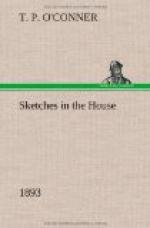[Sidenote: The triumph of the tweed coat.]
It is one of the curious things about Parliamentary life in England, that the smallest detail of personal habit attracts the all-searching gaze of the entire world. Let a man change the shape of his hat, the colour of his clothes, the style even of his stockings, and the world knows it all before almost he is himself conscious of the change. And then, though the House of Commons consists for the most part of men well advanced in middle life—men who have made their pile in counting-house or shop, before devoting themselves to a Parliamentary career—it is also a House where wealth and fashion are very largely represented. It is often a very well-dressed body; and in this House of Commons, in particular, there is a very large proportion of well-tailored and well-groomed young men—especially, of course, on the Tory side. The consequence is, that you are able to trace the transformations of fashion, the processions of the seasons, the variety of appropriate garbs which social and other engagements impose, as accurately in the House of Commons as in Rotten Row.
[Sidenote: The old order.]
The ordinary tendency of the Parliamentary man is towards the sombre black, and the solemnity of the long-tailed frock-coat. There have been times when if a member of Parliament did venture to enter the House of Commons in a coat prematurely ending in the short tails of the morning coat, or in the tail-less sack-coat, he would have been called up to the Speaker’s chair and as severely reprimanded as though he had committed the most atrocious offence—in those far-off days—of wearing a pot-hat. But in these democratic times one can do anything; and low-crowned hats, sack-coats, homespun Irish tweeds, affright and shock the old aristocratic Parliamentary eye. When summer approaches, the whole aspect of the House changes. The sombre black is almost entirely doffed; and you look on an assembly as different in its outward appearance from its antecedent state as the yellow-winged butterfly is from the grim grub. Indeed, members of Parliament seem to take a delight in anticipating the change of dress which the change of season imposes. There are members of the House of Commons who can claim to wear the very first white hat of the season. Sir Wilfrid Lawson has a sombre creed and a Bacchanalian spirit; and, accordingly, the very first time a mere stray gleam of sunshine streaks the wintry gloom Sir Wilfrid wears an audaciously white hat.
[Sidenote: Mr. Gladstone’s rejuvenescence.]
Mr. Gladstone is a curious mixture of splendour and carelessness. He nearly always wears a small, narrow black tie, which brings into greater relief the Alpine heights and the measureless width of his big shirt-collars, and the broad expanse of his shirt-front. But this tie—though it marks a pleasant and becoming individuality of dress—loses half its effect by nearly always getting out of its




